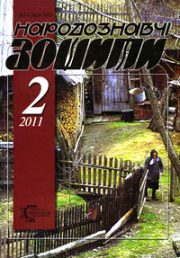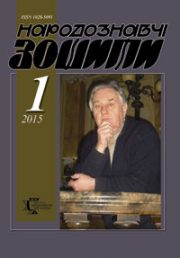The Ethnology Notebooks. 2024. № 2 (176), 336—345
UDK 39(=162.1:292.452):[633/635.054:615.89]
DOI https://doi.org/10.15407/nz2024.02.336
TREE IN FOLK MEDICINE OF UKRAINIAN HIGHLANDERS
NAKONECHNA (HOSHCHITSKA) Tetiana
- ORCID ID: https://orcid.org/0000-0001-8596-8974
- Doctor of Philosophy, researcher fellow
- of the department of Historical Ethnology
- of the Institute of Ethnology
- The National Academy of Sciences of Ukraine,
- 15, Svobody Avenue, 79000, Lviv, Ukraine,
- Contacts: e-mail: hoshchitska.tetiana@gmail.com
Abstract. Introduction: Folk medicine was a complex complex in which positive empirical knowledge and means of healing magic were combined, folk tradition and later elements that flowed into it from professional, foreign influences and observations and adaptation to local conditions, layering of beliefs originating from different eras, etc. Problem Statement: Therefore, in this field of folk knowledge, various relics of ancient worldviews, which continued to function in the daily life of certain ritualized forms of behavior, various taboos, verbal formulas, etc., often remained preserved. It is to such relict phenomena that various aspects relating to trees in the methods of folk therapy should be attributed, which often carry an echo of ideas of extremely distant eras. Actually, this determines the relevance of the proposed research. The purpose of articles is an attempt to comprehensively outline the place of the tree in the techniques of folk therapy, both in the utilitarian sense and to the greatest extent in the symbolic sense. The object of the study is the traditional medicine of the Ukrainian Carpathians, and the subject is the tree in the methods of folk therapy in its broadest aspects. The scientific novelty of the proposed study is that for the first time an attempt has been made to examine in detail the use of wood in folk therapy, and various beliefs associated with ceremonial trees and their alloforms, with specific wood species that have somehow been reflected in the techniques and practices of folk treatment. The main methods used by the author are structural, typological analysis, historical reconstruction and comparative methods. Results:
Keywords: ceremonial tree, folk medicine, folk veterinary medicine, ordering, Ukrainian Carpathians, Bojky, Lemky, Hutsuls.
Received 21.02.2024
REFERENCES
- Boltarovych, Z.E. (1980). Folk healing of the Carpathian Ukrainians of the late 19th and early 20th centuries. Kyiv: Naukova dumka [in Ukrainian].
- Boltarovych, Z.E. (1990). Folk medicine of Ukrainians. Kyiv: Naukova dumka [in Ukrainian].
- Popov, A.P. (1968). Medicinal plants in folk medicine. Kyiv: Health [in Russian].
- Matsievskyi, O., & Goshko, Yu. (2002). Folk medicine and veterinary medicine. In Lemkivschyna (Vol. 2, pp. 140—152). Lviv: In-tut narodoznavstva NANU [in Ukrainian].
- Halaychuk, V. (1999). Functioning and semantic features of phytonyms in Ukrainian and Russian texts of orders. In: Bulletin of Lviv University. Philological series (Issue 27, pp. 87—97) [in Ukrainian].
- Halaychuk, V. (2003). Peculiarities of everyday life and notable structural and semantic features of Middle Polish orders of diseases (on the material of texts from Olevsky District, Zhytomyr Region). In: Bulletin of Lviv University. Philological series (Issue 31, pp. 113—131) [in Ukrainian].
- Halaychuk, V. (2003). Phytonym «oak» as a formant of folklore «picture of the world». Semantics, pragmatics, syntagmatic and paradigmatic connections. In: Bulletin of Lviv University. Philological series (Issue 30, pp. 182—196) [in Ukrainian].
- Halajchuk, V. (2006). Mythological representations about plants. In: Ethnogenesis and ethnic history of the Ukrainian Carpathians (Vol. 2, pp. 590—608). Lviv: Instytut narodoznavstva NAN Ukrainy [in Ukrainian].
- Halaychuk, V. (2016). Ukrainian mythology. Kharkiv: Family Leisure Club [in Ukrainian].
- Shukhevych, V. (1904). Hutsul’schyna (Vol. V, pp. 1—301) [in Ukrainian].
- Shukhevych, V. (1908). Hutsulshchyna: the fifth part. Lviv [in Ukrainian].
- Franko, I. (1898). Hutsul orders. Etnohrafichnyj zbirnyk (Vol. V, pp. 41—72) [in Ukrainian].
- Franko, I. (1908). Galician-Russian folk sayings. Etnohrafichnyj zbirnyk (Vol. 24, pp. 1—541) [in Ukrainian].
- Onischuk, А. (1909). Materials to the Hutsul demonology, written in 1907—1908 in Zelenitsy, Nadvirna district by Antin Onischuk, the folk teacher. Materiialy do ukrains’koi etnol’ohii (Vol. 11, pp. 1—139) [in Ukrainian].
- Kolessa, F. (1898). Popular beliefs in Pidhiria in the Khodovychi village, Stryi povit, recorded by Filaret Kolessa. Etnohrafichnyj zbirnyk (Vol. V, pp. 76—98) [in Ukrainian].
- Potushnyak, F. (1941). Suicide in folk beliefs. Literary and scientific supplement to the Carpathian Sunday, 2 (1), 31—32 [in Ukrainian].
- Shekeryk-Donnykiv, P. (2009). The year in beliefs of Hutsuls [in Ukrainian].
- Warhol, N. (1992) People’s imagination about a tree. In: Scientific collection of the Museum of Ukrainian Culture in Svydnik (Issue 18, рр. 228—244) [in Ukrainian].
- Siletskyi, R. (2011). Traditional building rituals of Ukrainians: monograph. Lviv: LNU named after I. Franko [in Ukrainian].
- Vasilechko, L. (2003). Echo trails. Ivano-Frankivsk [in Ukrainian].
- Pakholok, I. (2012). «May» («kletchannia») — the key attribute of the Green Holidays (Carpathian tradition). In: Fortecia — the collection of «Tustan» reserve (Book 2, pp. 574—582). Lviv [in Ukrainian].
- Horoshko-Pohorets’ka, L. (2021). Water in ritual: Carpathian tradition. Lviv: Institute of Ethnology of the National Academy of Sciences of Ukraine [in Ukrainian].
- (2016). Ethnographic image of modern Ukraine. Corpus of expeditionary ethnographic and folklore materials (Vol. 3: Birth ritual). Kyiv: IMFE [in Ukrainian].
- Boltarovych, Z.E. (2005). Pages of the expedition diary. The Ethnology notebooks, 1—2, 197—202 [n Ukrainian].
- Ostapyk, O. (1991). Field materials from the expedition to the Starosambir district, to the Boykivshchyna. In: Archive of the IN NANU. F. 1. Оp. 2. Od. save 370 [in Ukrainian].
- Ivanov, P.V. (1991). Folk tales about witches and ghouls. In: Ukrainians: folk beliefs, superstitions, demonology (Pр. 430—497). Kyiv: Lybid [in Ukrainian].
- Agapkina, T.A. (2012). Ash tree. Slavic antiquities: Ethno linguistic dictionary (Vol.5). Moscow: Mezhdunarodnyye otnosheniya (Vol. 5, pp. 637—638) [in Russian].
- Antoniv, P. (2014). Narodne vesillia v Oslavytsi na Lemkivschyni. The Ethnology notebooks, 1, 98—102 [in Ukrainian].
- Radovych, R. (2020) Construction rituals of Boykivs (based on materials from the eastern and middle parts of Boykivshchyna). The Ethnology notebooks, 2, 330—349. DOI https://doi.org/10.15407/nz2020.02.330 [in Ukrainian].
- Hnatyuk, V. (1919). Human figurines made of wax. Notes of the Shevchenko Scientific Society (Vol. СХХVІІІ, pp. 212—216) [in Ukrainian].
- Samotis, Y. (2012—2013). Field ethnographic materials to the topic Traditional spring ritual of Ukrainians recorded in Bogorodchany, Kosiv and Verkhovyna districts of Ivano-Frankivsk region, Putyla district of Chernivtsi region; in the Great Bereznyansky and Perechyn districts of the Transcarpathian region). In: Archive of the IN NANU. F. 1. Оp. 2. Оd. save 725 [in Ukrainian].
- Voitovych, N. (2015). Folk Demonology of Boykivshchyna [in Ukrainian].
- Pasternak, Ya. (1936). Jordan — Vodokhryshchi. Life and know ledge, 12 (ІХ), 9—12 [in Ukrainian].
- Ganus, D.M. (2015). A child in the system of folk beliefs and rituals of the population of the Ukrainian-Polish border (Dissertation). Ivan Krypiakevych Institute of Ukrainian Studies of the National Academy of Sciences of Ukraine [in Ukrainian].
- Halaychuk, V. (2010). From the Spiritual Culture of Bohorodchany Region: Customs, Beliefs and Legends Related to the Conceptual Representation of Death and the Dead. Mythology and Folklore, 3—4 (7), 27—49 [in Ukrainian].
- Ostapyk, O. (1994). Field materials from the expedition to the Boikivshchyna. Archive of the IN NANU. F. 1. Оp. 2. Оd. save 400 [in Ukrainian].
- Serebryakova, O. (2014). Field materials collected in Tlumatsky, Tysmenytskyi, Horodenkivsky districts, Ivano-Frankivsk region. Archive of the IN NANU. F. 1. Оp. 2. Оd. save 771 [in Ukrainian].
- Hoshchitska, T. (2008). Ethnographic field materials on the topic «National construction», collected in the Skoliv district of the Lviv region, by Tetyana Bohdanivna Goshchytska. Archive of the IN NANU. F. 1. Оp. 2. Оd. save 576. [in Ukrainian].
- Kohlberg, O. (1990). Tales of Pokuttia. Uzhhorod: Carpathians [in Ukrainian].
- Novyk, E.S. (Ed.). (1990). Myths, legends, tales of Khants and Manses. Moscow: Nauka: Main editorial office of eastern literature [in Russian].
- Agapkina T.A. (2012). Тhrough. Slavic antiquities: Ethno linguistic dictionary (Vol. 5, рр. 12—16). Moscow: Mezhdunarodnyye otnosheniya [in Russian].
- Falkowski, J. (1937). On the west border of Hutsylshchuna: on the wallej of Prut, Bystrzyca Nadwornianska, Bystrzyca Solotwinkia i Lomnica. Lviv [in Polish].
- Chubynskyi, P.P. (1872). Proceedings of the ethnographic and statistical expedition to the Western (1872). Russian region, equipped by the Russian Geographical Society of the South-Western Department, collected by P.P. Chubinsky (Vol. 1). St. Petersburg [in Russian].
- Ignatenko, I. (2013). Folk medicine of Central Polissia: traditions and modernity (based on field ethnographic materials). Kamianets-Podilskyi [in Ukrainian].
- Schnajder, J. (1910). People of Pechenizhyn. Lud, ХIII, 21—33 [in Polish].
- Lepkij, D. (1884). About folk superstitions. The Zoria: pys’mo lyteraturno-naukove dlia ruskykh’ rodyn’, 13, 105—107 [in Ukrainian].
- Mushinka, M. (2008). Conspiracies and calendar rites of Kurov village. In: Mushinka M. From the father’s threshold. Collected works (Vol. 1, pp. 442—498) [in Ukrainian].
- Dzendzelevsky, I.A. (1984). Prohibitions in the practice of Carpathian sheep breeders. In: Slavic and Balkan folklore (Pр. 256—277) [in Ukrainian].
- Hladkyj, M. (1999). Pastoral orders for Polssians. In: Polissia Ukrainy (Issue 2, рр. 273—292) [in Ukrainian].
- Gnatyuk, V. (2000). Description of Ukrainian mythology. Lviv: In-tut narodoznavstva NANU [in Ukrainian].
- Petrov, A. (1891). Hungarian-Russian conspiracies and incantations of the beginning. XVIII s. Zhyvaia staryna, 4, 122—130 [in Russian].
- Moskalenko, M.N. (1993). Ukrainian orders. Kyiv: Dnipro [in Ukrainian].
- Franko, I. (1898). Folklore materials from the collection of Prof. Raimund Kaindl. Etnohrafichnyj zbirnyk (Vol. 5, 146—159) [in Ukrainian].
- Halaychuk, V. (2015). Traditional ideas about the snake on the Right Bank of Polissia. In: Scientific Notebooks of the Faculty of History of Lviv University (Issue 16, pp. 155—171) [in Ukrainian].
- Levkievskaya, E.E. (2002). Slavic amulet. Semantics and structure. Моscow: Indrik [in Russian].






